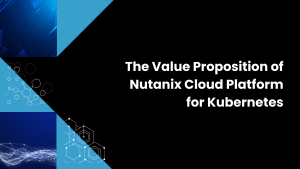Earnings season has shown a conflicting mix of signals for software companies. Most firms are expressing caution over macro headwinds citing a combination of Ukraine, inflation, interest rates, EMEA softness, currency, supply chain and general demand for technology. But MongoDB, along with a few other names appeared more sanguine, thanks to a beat in the recent quarter and a cautious but upbeat outlook for the near term.
In this Breaking Analysis, ahead of MongoDB World 2022, we drill into the company’s business and what ETR survey data tells us in the context of overall demand and the patterns from other software companies.
Software Companies Send Mixed Earnings Messages
We’re seeing some distinctly different results and guidance from major software companies in recent days.
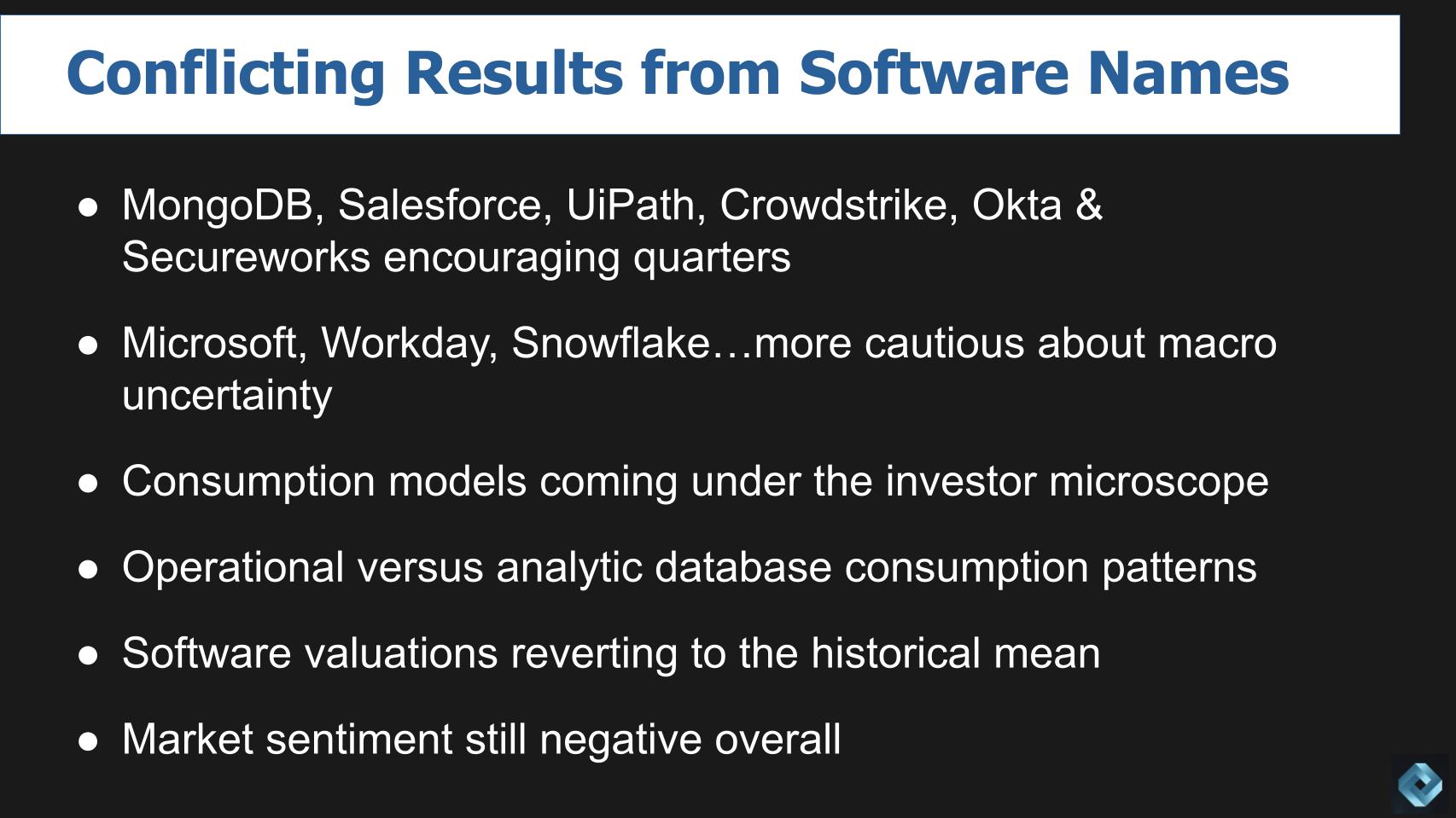
We’ll dig deeper into MongoDB in this post. The company beat EPS by 30 cents and revenue by more than $18M this past quarter. Salesforce had a great quarter and its diversified portfolio is paying off as seen by the stock’s noticeable uptick post earnings. UiPath, which had been hammered prior to this quarter has brought in a co-ceo and its business is showing a nice rebound with a 3 cent EPS beat and a nearly $20M top line beat. Crowdstrike, Okta & Secureworks showing demand for security software remains strong.
Meanwhile managements at Microsoft, Workday and Snowflake expressed greater caution about the macroeconomic climate. Especially on investors’ minds is concerns about consumption pricing models. Snowflake, which had a small top line beat, cited softness and negative effects from reduced consumption, especially from certain consumer-facing customers…which has analysts digging more deeply into the predictability of their models.
Wall Street Analysts Puts Consumption Models Under a Microscope
Barclays analyst Raimo Lenschow published an especially thoughtful piece on this topic, concluding that Mongo was less susceptible to consumption headwinds than, for example Snowflake. Essentially for three reasons: 1) Atlas, Mongo’s cloud managed service, comprises only about 60% of Mongo’s revenue; 2) A premise that Mongo is supporting core operational applications that can’t be easily dialed down; and 3) Snowflake customers are more concentrated and due to the fact that a preponderance of its revenue is consumption-driven it will be more sensitive to swings in consumption patterns.
Our view is that consumption pricing models are here to stay and the much preferred model by customers. The appeal of consumption is you can actually dial down spend if needed. And that’s what happened with certain Snowflake customers this quarter, adding credibility to the model. In fact many business cases include this dynamic as a benefit of moving to a platform with consumption-based pricing. Admittedly, procurement often wants to put caps and limits on the spend and/or negotiate volume discounts.
But to the point about Mongo supporting core applications versus Snowflake workloads being more discretionary. We believe that over time you will see the increased emergence of data products and services that will become core monetization drivers for organizations. We’re already seeing that today in fact in data markets for example, where data is the product. Snowflake, along with other data platforms, feeds these data products and will become increasingly less susceptible to the sensitivities we heard about on the Snowflake earnings call and are being discussed in the community.
Valuations Reverting to the Mean & the Market is Still Bearish
The last two points in the slide above speak to valuations and market sentiment. Software valuations have reverted to their historical mean, which is a good thing in our view – we’ve taken some of the air out of the bubble and a return to more normalized valuations is a welcome buying opportunity for many investors. And we’re still in a lousy market for stocks, which, together with lower valuations could mean a bottom is forming. The market tends to be at least six months ahead of the economy and often, not always, but often a good predictor of what’s ahead. We’ve had some tough compares to the boom in tech during the pandemic and we’ll be watching next quarter closely because the macro headwinds have now been firmly inserted into the guidance assumptions of software companies. Meaning if demand picks up and companies rebound next quarter the market could improve.
Tough Year for Holding High Growth Software Companies
Let’s have a look at how two proxies for high flying names, MongoDB and Snowflake, have fared relative to the broader software market and some larger, more profitable software companies.
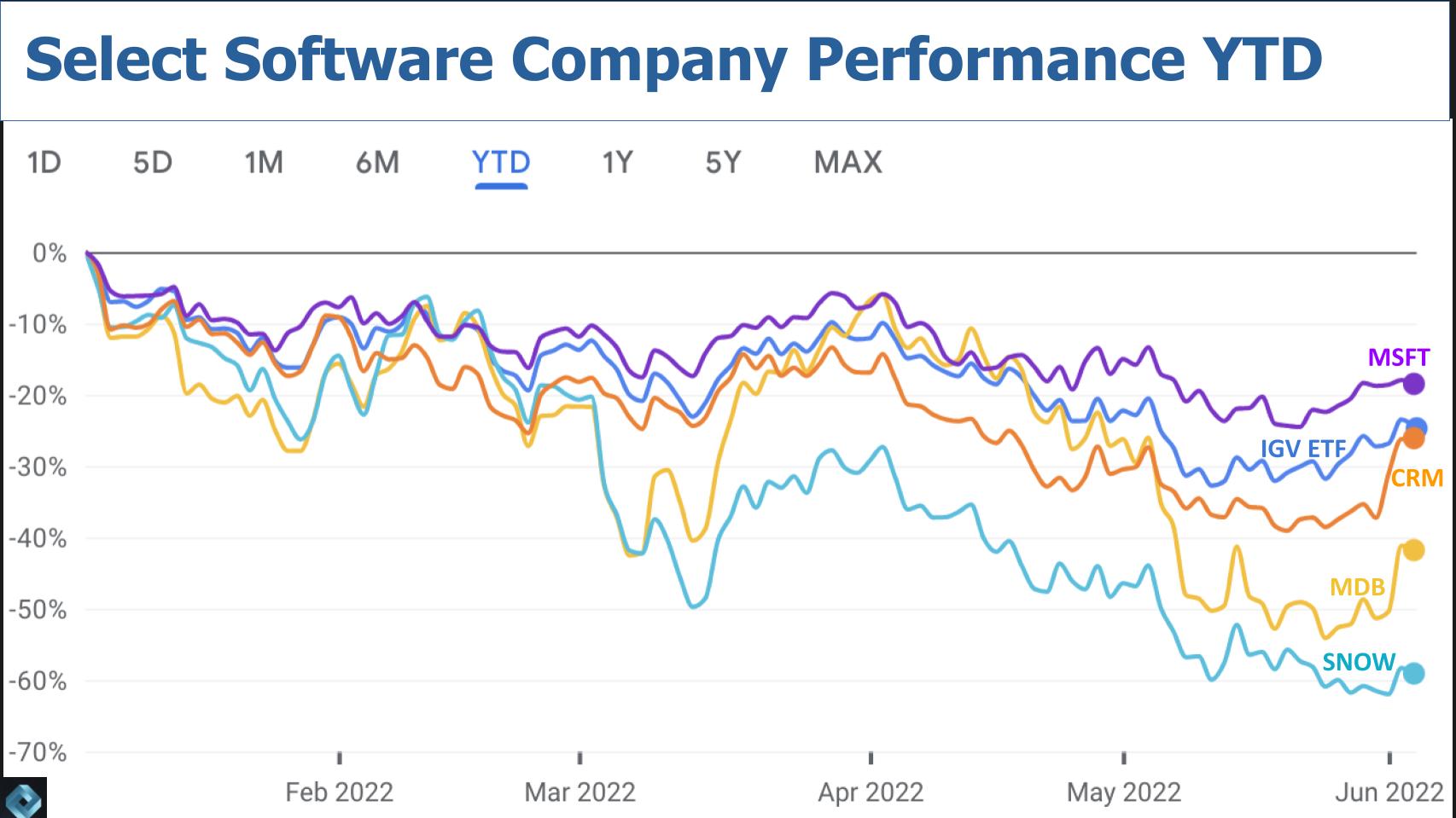
The chart above shows year-to-data data comparing the performance of Microsoft, Salesforce, MongoDB & Snowflake to the IGV Software-heavy ETF (the darker blue line). The ETF doesn’t own Snowflake or Mongo by the way. You can see the super caps, Microsoft and Salesforce, have fared pretty well relative to the benchmark, whereas Mongo and especially Snowflake– i.e. the higher growth companies — have been much more impacted.
We don’t show Oracle in the chart but it’s another example of a profitable, large cap stock that has outperformed the software benchmark we’ve used. In fact Oracle for most of the year has outperformed even Microsoft.
Financial Snapshot: Comparing MongoDB to Snowflake
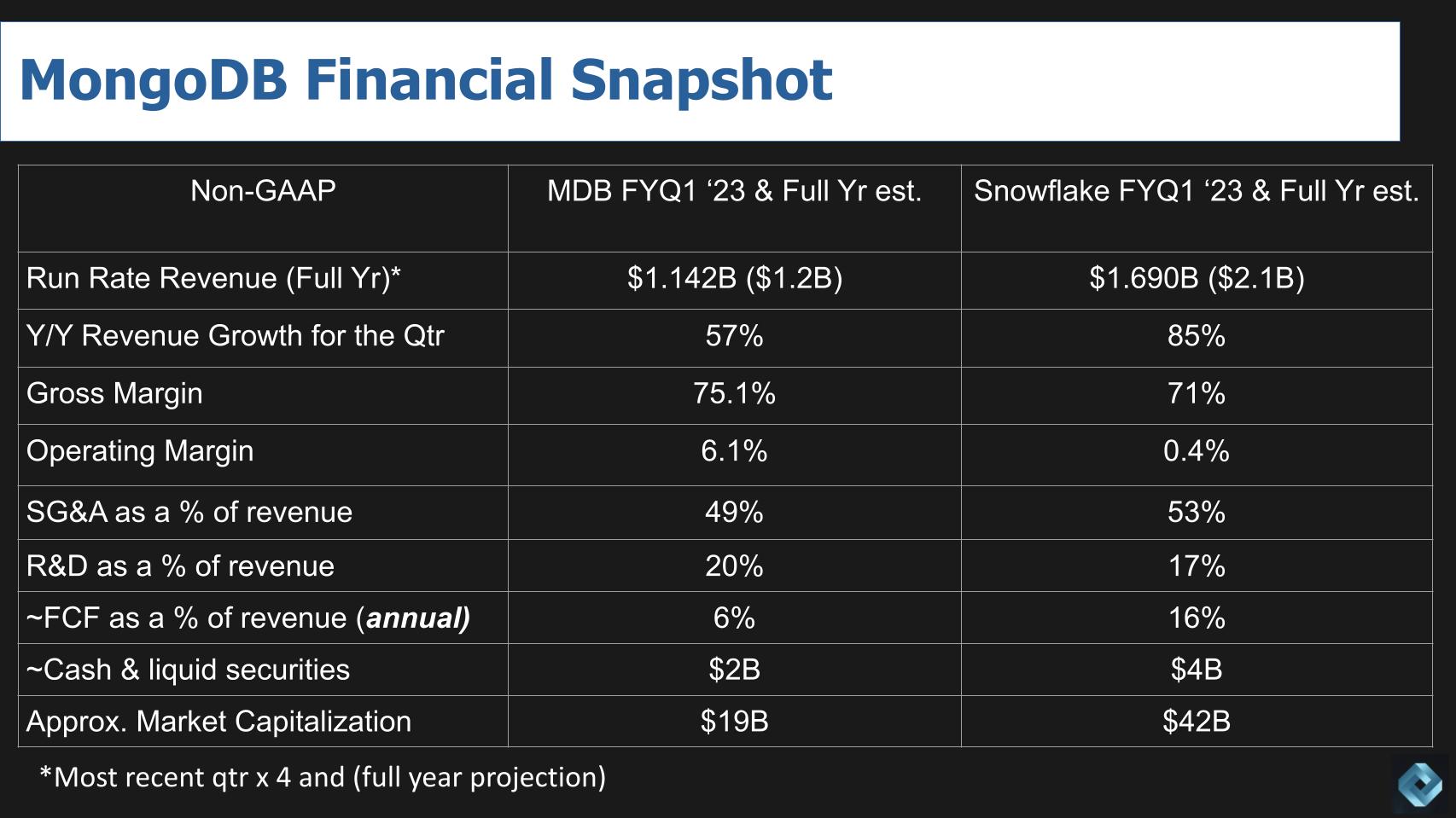
What we’ve done above is take the most recent quarter’s revenue and multiplied it by 4X to get a revenue run rate. And parenthetically added a projection for full year revenue. Mongo will do north of a billion dollars in revenue while Snowflake will surpass $2B in FY ’23. Snowflake is on its way to $3B in FY ’24 revenue. Its billings will likely hit $2.7B in FY ’23. MongoDB on the other hand will likely land in the $1.5 – $1.6B range in FY ’24. You can see Snowflake is growing faster at 85% this past quarter and is projected to grow faster than MongoDB into FY ’24.
We took most of these profitability ratios from the current quarter except for free cash flow. Both companies have high gross margins but as we’ve discussed, not as high as some traditional software companies, in part because of their cloud COGS but also their maturity. Both Mongo and Snowflake, because they are in growth mode, have thin operating margins. They spend about half their revenue on growth – that’s the SG&A line – mostly the S category. They are companies with a specialized focus so they spend a fair amount of their revenue on R&D..maybe not as high as you might think but a hefty percentage.
The free cash flow as a percentage of revenue line we calculated from the full year projections and you can see Snowflake’s free cash flow will settle in at around 16% this year versus Mongo’s 6%. Rounding up, Snowflake has about $4B in cash and marketable securities on its balance sheet, with little to no debt whereas Mongo has about $2B with some longer term debt.
And you can see Snowflake’s market capitalization is about double that of Mongo’s so you’re paying for higher growth, the Slootman / Scarpelli execution expectation, a stronger balance sheet and quite a bit more hype. But Snowflake’s market cap is well off its roughly $100B valuation that it touched during the pandemic.
And as an aside, Mongo has around 33,000 customers – about 5 times the number of customers Snowflake has. So a bit of a different customer mix and concentration. Both companies have no lack of market in our view.
Customer Spending Patterns on MongoDB
Let’s dig a little deeper into Mongo’s business and bring in some ETR survey data.
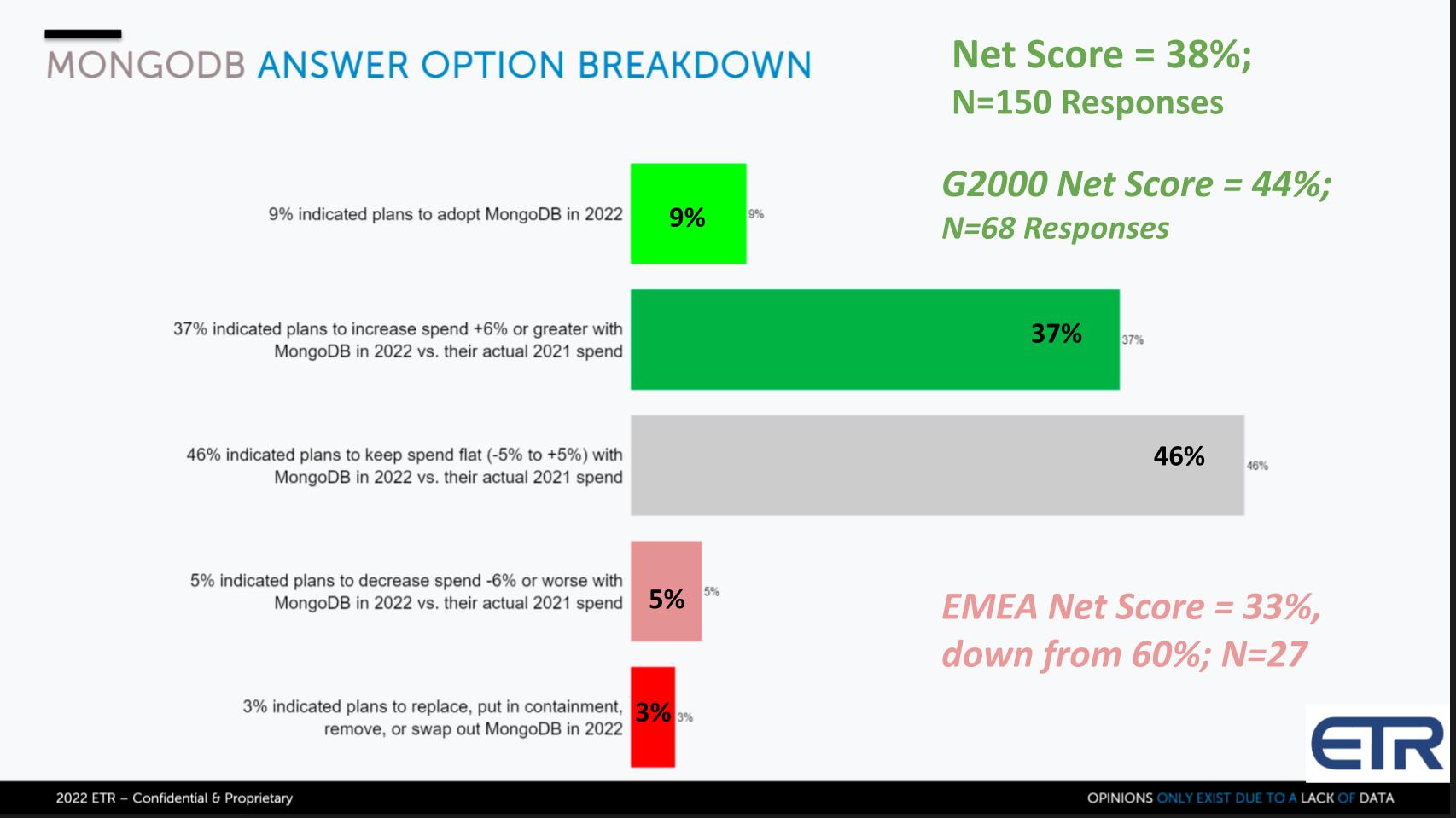
The colorful chart above shows the breakdown of Mongo’s Net Score. Net Score is ETR’s proprietary methodology that measures the percent of customers in their quarterly survey that are adding the platform new – that’s the lime green at 9%. Existing customers spending 6% or more on the platform – that’s the forest green at 37%. Flat spend – the gray at 46%. Decreasing spending by 6% or more – the pinkish at 5%. And churning, that’s the red at 3%. Subtract the reds from the greens and you net out to 38%. A very solid spending picture for Mongo.
Note that this survey of 1,200+ organizations includes 150 MongoDB customers. It includes 68 G2000 MongoDB customers and those larger firms are showing a spending velocity of 44% – so notably higher among larger clients. And while it’s a smaller sample of only 27, EMEA’s Net Score for Mongo is 33%, down from 60% last quarter. Mongo cited softness in its European business so that aligns with the ETR survey data.
MongoDB’s Position Relative to Peers
In the chart below, we plot Mongo relative to some other data platforms. These don’t all necessarily compete head to head with MongoDB but they reflect data and database platforms that can serve a variety of workloads.
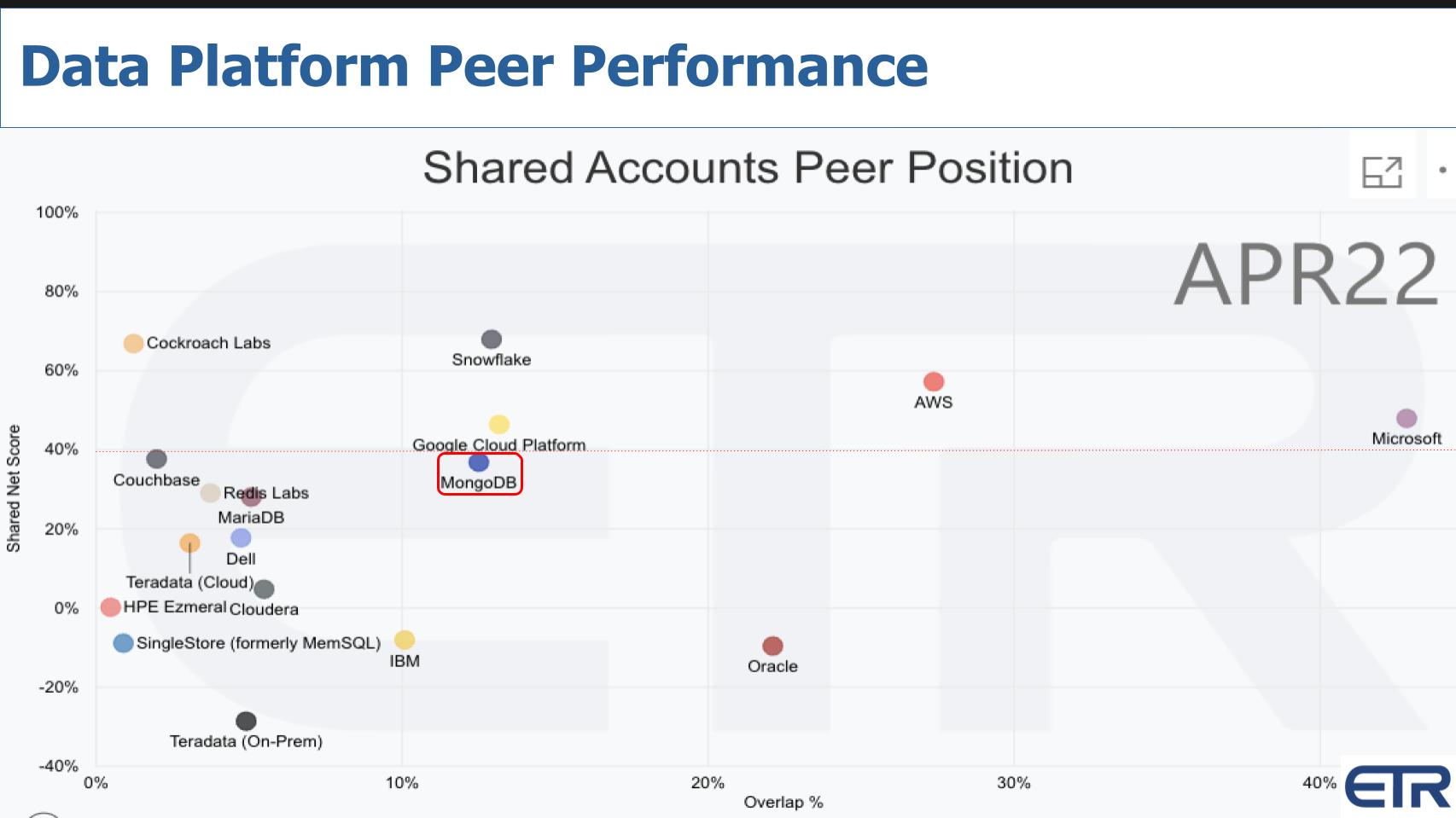
The chart depicts an XY graph with Net Score or spending momentum on the vertical axis and Overlap or presence in the dataset on the horizontal axis. The red dotted line at 40% indicates an elevated level of spending. We’ve highlighted Mongo which is very close to that line and has a strong presence on the X axis. Right there with GCP. Snowflake as we’ve reported several weeks ago has come down to earth, again aligning ETR data with the earnings results. But Snowflake remains well elevated relative to its peers. AWS and Microsoft have many data platforms that are captured in this data, so their plot positions reflect broad data platform portfolios, massive estates and their large presence in the market.
And you see the pack of others including Cockroach – small but elevated, Couchbase creeping up since its IPO, Redis, MariaDB, and some legacy platforms including the leader in database, Oracle, along with IBM and Teradata’s cloud and on-prem platforms.
One interesting side note is on Mongo’s earnings call, executives clearly cited the advantages of its increasingly all-in-one approach, relative to others that offer a portfolio of bespoke, “horses for courses” databases. Mongo cited the advantages of its simplicity and lower costs as it adds more and more functionality for developers. Oracle ironically often makes a similar argument, especially targeting AWS. MongoDB doesn’t call out AWS as does Oracle but clearly Amazon is the poster child for lots of data platforms that are more focused on specific workloads, versus trying to put more function into a single database service to consolidate platforms.
And of course Mongo would differentiate from Oracle, making the argument that Oracle, as a traditional relational database, is more complex, less flexible and less appealing to developers. And Oracle would counter and that they now support a MongoDB API, so why go anywhere else? To us, this gives credence to the fact that if Oracle is trying to capture business by offering a Mongo API…Mongo must be doing well!
Why do Customers Buy MongoDB?
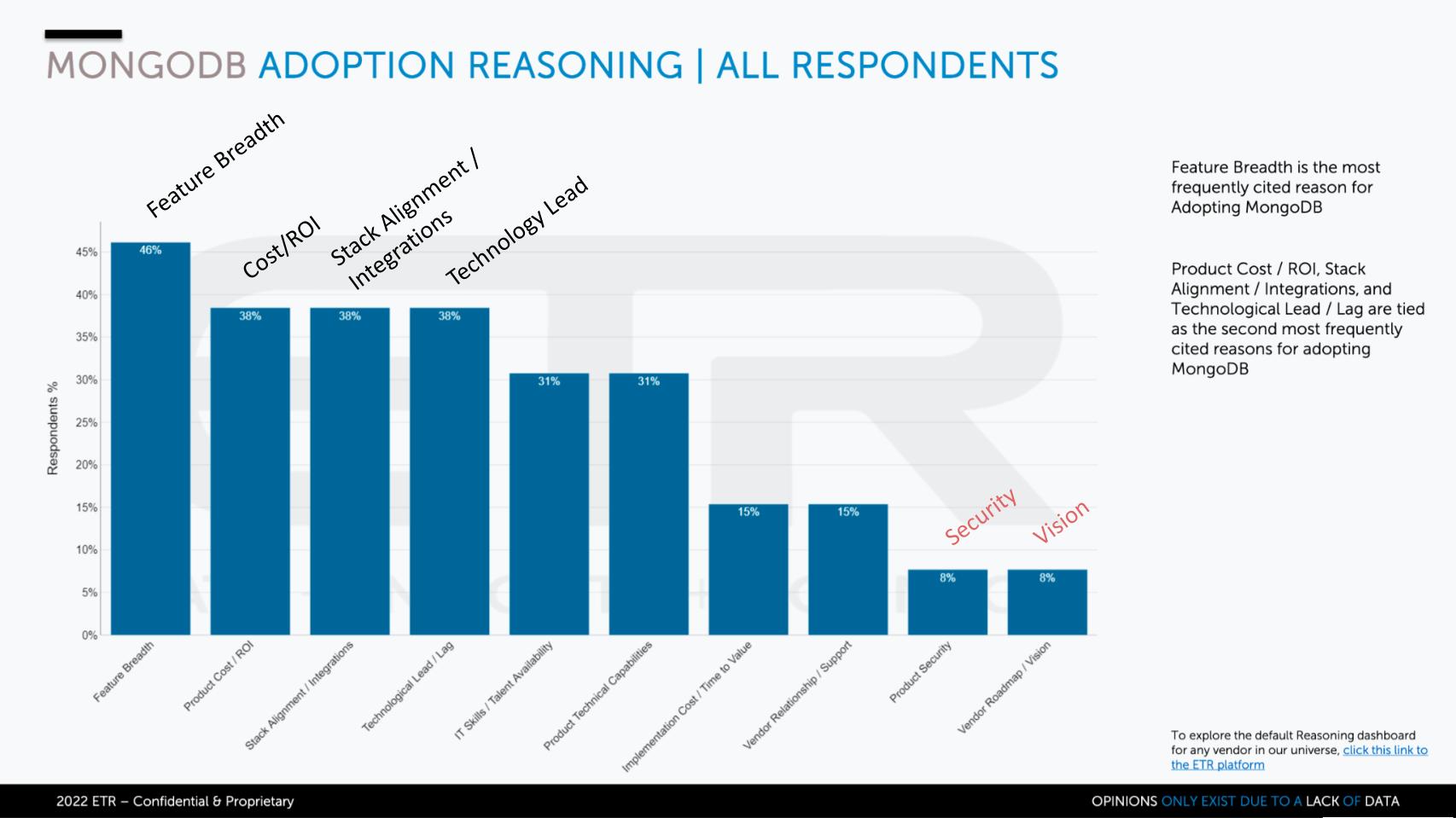
The data above is an ETR chart that addresses the reasons for adopting the platform. Mongo customers cite its feature breadth as the #1 reason, followed by lower costs/better ROI #2, integrations and stack alignment #3 and Mongo’s technology lead #4. With security and vision much lower as shown on the right. This doesn’t necessarily mean Mongo has security issues, although it has been cited as a concern by customers.
Mongo is a document database. It’s become a viable alternative to traditional relational databases. Meaning you have much more flexibility over your schema. You can pretty much put anything into a document database. Developers seem to love it because it’s simple for them. Generally it’s fair to say Mongo’s architecture favors consistency over availability…it uses a single master architecture as a primary node. Customers will create secondary nodes in the event of a primary failure but you have to think about that and consider recovery more carefully.
No fixed schema means it’s not a tables and rows structure and you can shove anything you want into the database but you have to think about how to optimize performance. So there are nuances and tradeoffs as with any architecture, however Mongo’s approach is gaining traction in the market because simplicity with lots of functionality is a winning formula.
To that point, Mongo has been hard at work evolving the platform from its early days as a pure document database by adding things like graph processing and time series, making search easier and more embedded into the platform. The company added several years ago. Atlas is a fully managed cloud database, which as we said earlier, now comprises 60% of Mongo’s revenue. The company has developed Kubernetes integrations and dozens and dozens of other features. Mongo has done a great job of creating a leading data platform today that is loved by customers and highly functional.
What to Look for at MongoDB World 2022
theCUBE will be at MongoDB world next week and here are some of the things we’ll be watching.
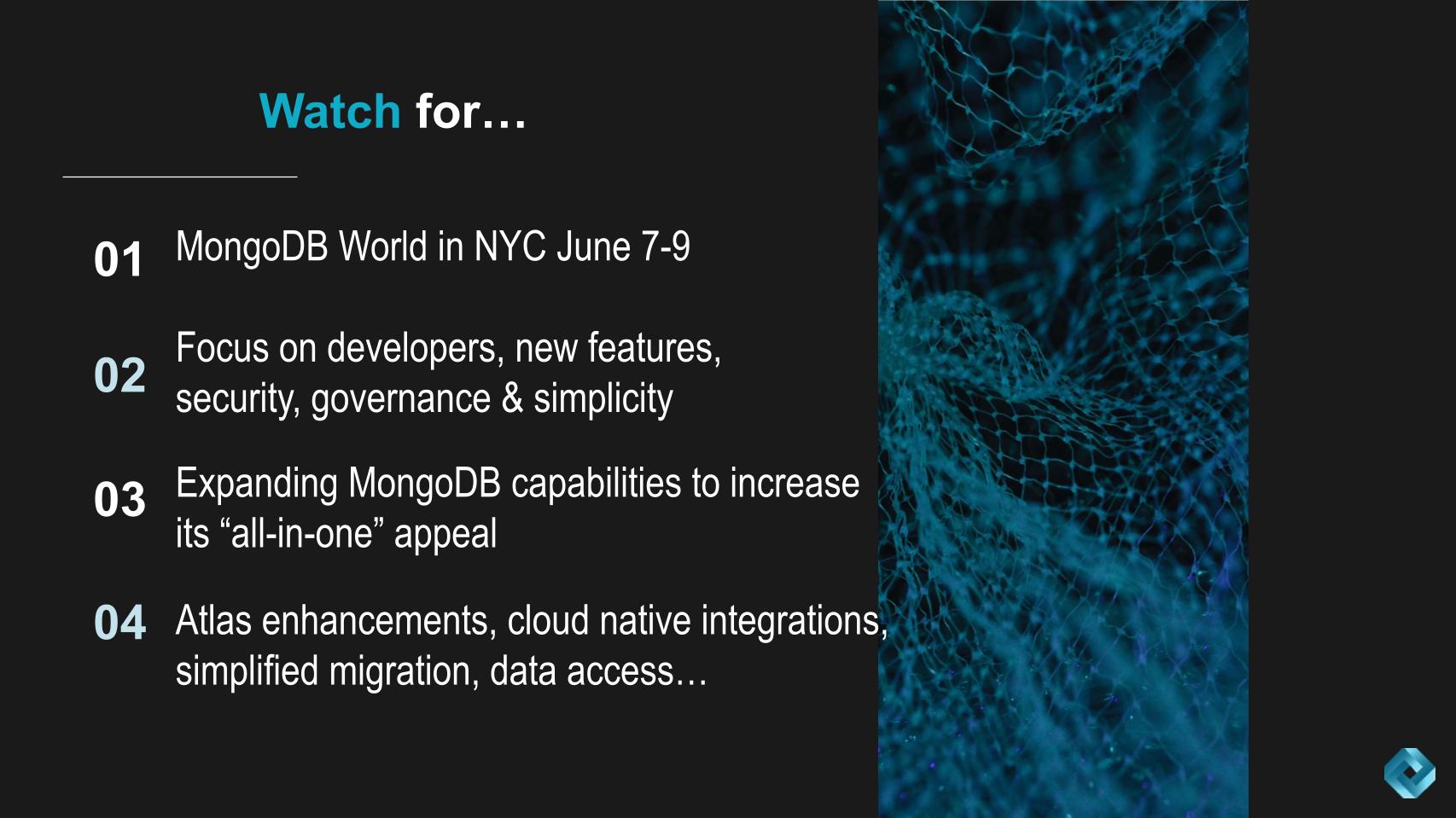
Mongo will always have a main focus on developers as the company prides itself on being a developer-friendly platform. Look for new features especially around security and governance and simplification of configurations and cluster management. Mongo will likely continue to advance it’s all-in-one appeal and add more capabilities that reduce the need to spin up bespoke platforms.
We would also expect enhancements to Atlas as that is the future of the company’s product portfolio. Expect more cloud native features and integrations, perhaps simplified ways to migrate to Atlas and improved access to data sources. The focus will likely be on generally making the lives of developers and data analysts easier.
These are the main things we’ll be scoping out at the event. So please stop by if you’re in NYC at the show or tune into our coverage on theCUBE.net.
Keep in Touch
Thanks to Stephanie Chan who researches topics for this Breaking Analysis. Alex Myerson is on production, the podcasts and media workflows. Special thanks to Kristen Martin and Cheryl Knight who help us keep our community informed and get the word out. And to Rob Hof, our EiC at SiliconANGLE. And special thanks this week to Andrew Frick, Steven Conti, Anderson Hill, Sara Kinney and the entire Palo Alto team.
Remember we publish each week on Wikibon and SiliconANGLE. These episodes are all available as podcasts wherever you listen.
Email david.vellante@siliconangle.com | DM @dvellante on Twitter | Comment on our LinkedIn posts.
Also, check out this ETR Tutorial we created, which explains the spending methodology in more detail.
Watch the full video analysis:
Note: ETR is a separate company from Wikibon and SiliconANGLE. If you would like to cite or republish any of the company’s data, or inquire about its services, please contact ETR at legal@etr.ai.
All statements made regarding companies or securities are strictly beliefs, points of view and opinions held by SiliconANGLE media, Enterprise Technology Research, other guests on theCUBE and guest writers. Such statements are not recommendations by these individuals to buy, sell or hold any security. The content presented does not constitute investment advice and should not be used as the basis for any investment decision. You and only you are responsible for your investment decisions.
Disclosure: Many of the companies cited in Breaking Analysis are sponsors of theCUBE and/or clients of Wikibon. None of these firms or other companies have any editorial control over or advanced viewing of what’s published in Breaking Analysis.


